La migration des colorants en sérigraphie peut être un problème frustrant, surtout lors de l'impression sur des tissus synthétiques comme le polyester. Il se produit lorsque le colorant du tissu commence à saigner dans l'encre imprimée, faire bouger ou s'estomper les couleurs de votre design ou s'estompe. Cet effet apparaît souvent après le processus de durcissement, Comme la chaleur active le colorant en tissu, conduisant à un mélange de couleurs indésirable.
Mais ne vous inquiétez pas - il existe des moyens efficaces de s'attaquer à cela! Utilisation d'encres à faible saignement, Appliquer une couche de blocage de colorant, et l'ajustement des températures de durcissement ne sont que quelques méthodes pour vous aider à garder vos impressions nettes et fidèles à la couleur. Avec ces techniques, Vous pouvez l'empêcher et vous assurer que vos conceptions restent aussi dynamiques que prévu.
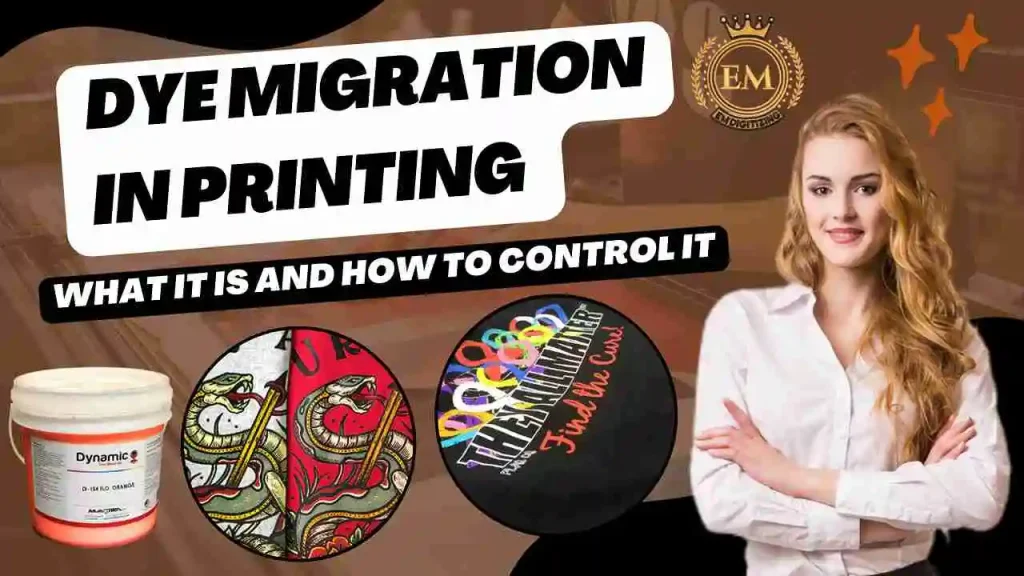
Migration des colorants dans l'impression: Qu'est-ce que c'est et comment le contrôler?
Qu'est-ce que la migration du colorant dans l'impression?
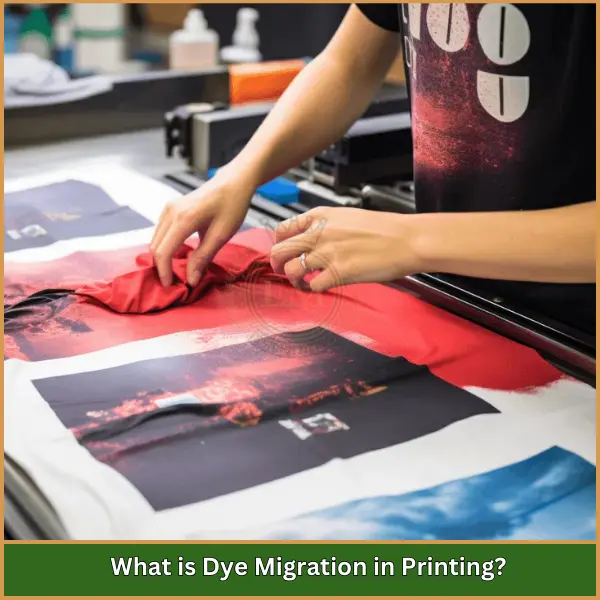
It refers to the process where dye from the fabric or garment material transfers or “;bleeds”; dans la couche d'encre d'un design imprimé. Ce problème se produit souvent dans les tissus synthétiques, en particulier le polyester, Lorsqu'il est exposé à la chaleur pendant le processus de durcissement. Les molécules de teinture deviennent mobiles et peuvent se déplacer dans l'encre, provoquant une décoloration ou une teinte, qui modifie les couleurs prévues de l'impression et réduit la qualité de l'impression globale.
Quels sont les facteurs qui provoquent la migration du colorant?
Cela se produit en raison de plusieurs facteurs qui influencent la façon dont les couleurs se déplacent en tissu. La compréhension peut aider à prévenir les changements de couleur indésirables dans vos impressions.
- Types de tissus sensibles
- Température de chaleur et de durcissement
- Qualité et stabilité du colorant
- Type d'encre et composition
- Niveaux d'humidité pendant l'impression
- Le temps et la pression appliqués
1. Types de tissus sensibles
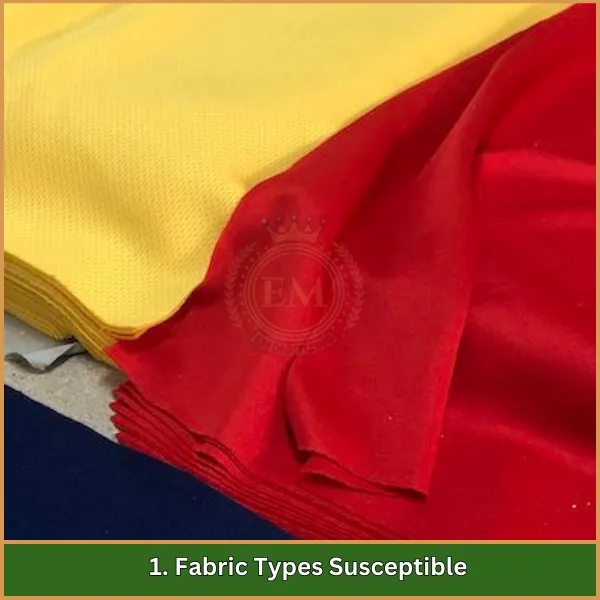
Certains tissus sont plus sujets à la migration dans l'impression que dans d'autres. Matériaux synthétiques, comme le polyester et le nylon, sont particulièrement sensibles car ils contiennent souvent des colorants sensibles à la chaleur. Lorsque la chaleur est appliquée pendant le processus d'impression, Ces colorants peuvent saigner dans la couche d'encre, provoquant une décoloration. Les tissus mélangés avec un pourcentage élevé de fibres synthétiques peuvent également rencontrer ces problèmes.
2. Température de chaleur et de durcissement
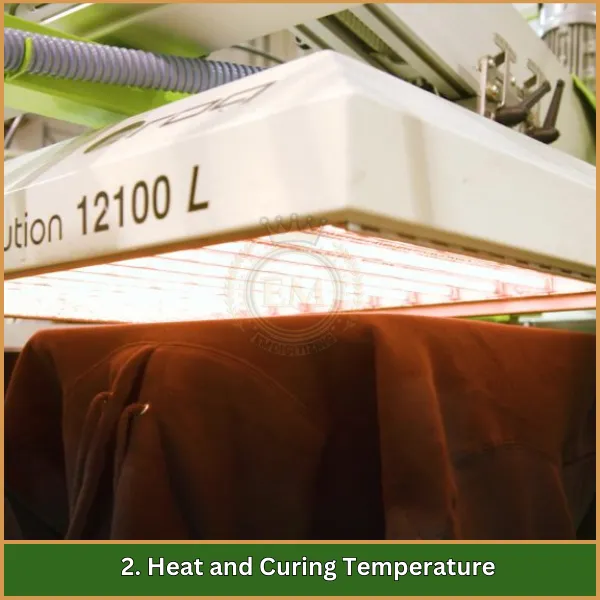
La quantité de chaleur utilisée dans le processus de durcissement est un facteur significatif de migration des couleurs. Lorsque la température est trop élevée, Il active le colorant dans les tissus synthétiques, lui permettant de migrer dans l'encre. Pour le minimiser, il est recommandé d'utiliser des températures de durcissement plus basses si possible, ou des encres à faible cure spécialisées qui réduisent le besoin de chaleur élevée.
3. Qualité et stabilité du colorant
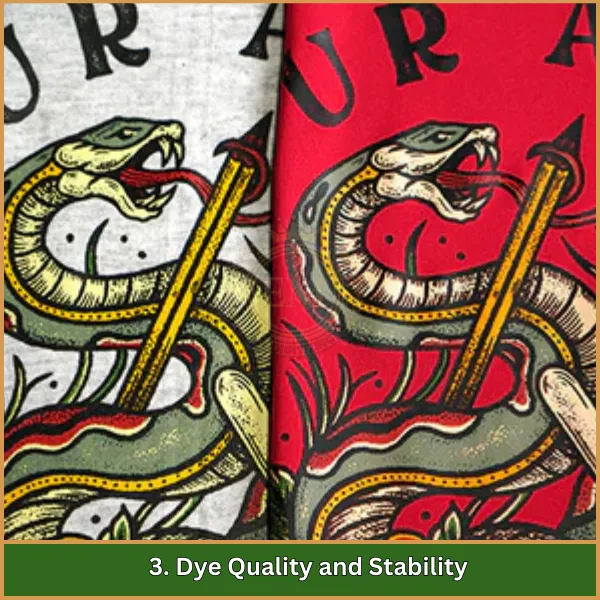
La stabilité du colorant utilisé dans le tissu joue un rôle majeur dans ce numéro. Les colorants de faible qualité ou instables sont plus susceptibles de saigner lorsqu'ils sont exposés à la chaleur et à la pression. Tissus teintes de haute qualité, Les colorants stables sont moins sujets à la migration, Assurer que les couleurs imprimées restent vraies.
4. Type d'encre et composition
Le type d'encre utilisé peut également affecter la migration des couleurs. Certaines encres sont formulées pour bloquer ou résister à la migration, les rendre adaptés à Impression sur des tissus synthétiques. Les exemples incluent:
- Encres de plastisol à faible saignement: Ces encres sont spécifiquement conçues pour réduire la migration en formant une couche de barrière entre le tissu et l'encre.
- Encres conviviales en polyester: Ces encres sont faites pour guérir à des températures plus basses, Réduire le risque de migration sur le polyester et les mélanges synthétiques.
- Encres sous-base en blocage des colorants: Ces encres agissent comme une couche d'amorce, Empêcher le colorant de s'infiltrer dans les couches supérieures de l'encre.
5. Niveaux d'humidité pendant l'impression
L'humidité dans l'environnement d'impression peut contribuer à la migration des couleurs. Une humidité élevée peut augmenter la teneur en humidité des fibres de tissu, les rendre plus sensibles à la migration d'impression liée à la chaleur pendant le durcissement. Il est essentiel de contrôler l'humidité dans la zone d'impression pour éviter un mouvement de colorant excessif.
6. Le temps et la pression appliqués
Le temps et la pression appliqués pendant le processus d'impression et de durcissement ont également un impact sur l'écran de migration de colorant. Une pression excessive ou une exposition à la chaleur prolongée peut entraîner le transfert de colorant plus facilement dans l'encre. Utiliser juste assez de pression et réduire le temps d'exposition pendant le durcissement peut aider à prévenir la migration, surtout sur les tissus sensibles.
Comment empêcher la migration du colorant dans l'impression d'écran?
Il est essentiel de maintenir la qualité de Designs imprimés sur des tissus synthétiques. Vous trouverez ci-dessous des méthodes efficaces pour aider à contrôler et comment résoudre les problèmes de migration des colorants dans l'impression d'écran.
- Utilisez des encres à faible saignement
- Température de durcissement plus basse
- Appliquer un sous-base de blocage de colorant
- Choisissez des tissus stables pour colorant
- Contrôler les niveaux d'humidité
- Utilisez des paramètres de pression et de temps appropriés
- Tests d'essai
1. Utilisez des encres à faible saignement
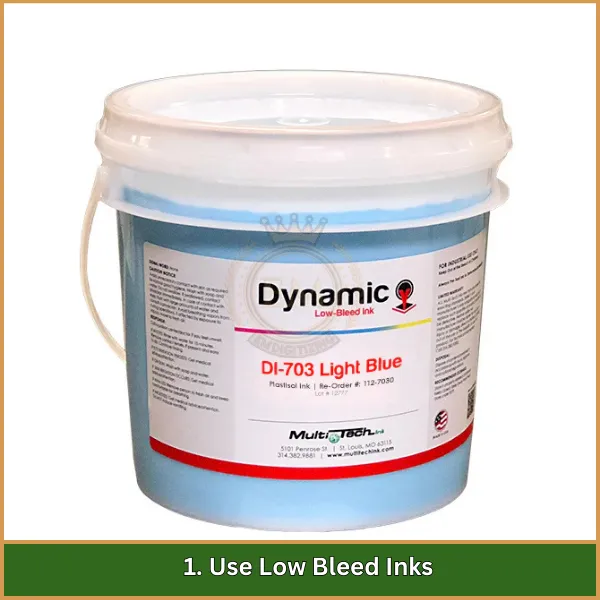
Ils sont spécialement formulés pour résister à la migration des couleurs en créant une barrière entre le colorant en tissu et l'encre imprimée. Ces encres agissent comme un bloqueur de migration de colorant, Idéal pour l'impression sur des tissus synthétiques, comme le polyester, où la migration est plus probable. L'utilisation d'encres à faible saut.
2. Température de durcissement plus basse

Les températures de durcissement élevées peuvent déclencher la migration dans les tissus synthétiques. L'abaissement de la température de durcissement réduit le risque de colorant se déplaçant dans la couche d'encre. De nombreuses encres à faible cure sont conçues pour guérir efficacement à des températures plus basses, En faire une excellente option pour réduire la migration dans l'impression d'écran.
3. Appliquer un sous-base de blocage de colorant

Un sous-base bloquant le colorant agit comme une couche d'amorce qui empêche le colorant de s'infiltrer dans l'encre imprimée. Ce sous-base, généralement blanc ou clair, est appliqué avant la couche d'encre principale pour créer une barrière protectrice. Il est particulièrement utile pour prévenir les migrations dans des tissus synthétiques foncés ou aux couleurs vives.
4. Choisissez des tissus stables pour colorant
Certains tissus sont teints avec stable, Des colorants de haute qualité qui sont moins sujets à la migration. Opter pour les tissus stables de colorant peut aider à réduire le risque de migration et à maintenir la conception imprimée intacte. Vérifiez les spécifications du tissu ou consultez les fournisseurs pour s'assurer que les matériaux utilisés conviennent à l'impression d'écran.
5. Contrôler les niveaux d'humidité
Une humidité élevée dans l'environnement d'impression peut augmenter la probabilité de migration. L'excès d'humidité rend les fibres de tissu plus sensibles à la chaleur, ce qui peut faire saigner le colorant. Le maintien de niveaux d'humidité optimaux dans l'espace de travail aide à contrôler le mouvement du colorant et produit des résultats d'impression plus cohérents.
6. Utilisez des paramètres de pression et de temps appropriés
Une pression excessive ou une exposition prolongée à la chaleur pendant le durcissement peut favoriser la migration des couleurs. En utilisant la bonne quantité de pression et en réduisant le temps de durcissement dans la mesure du possible, vous pouvez minimiser le transfert de colorant dans l'encre. L'ajustement de ces paramètres en fonction du type de tissu peut aider à prévenir la migration et à améliorer la qualité de l'impression finale.
7. Tests d'essai
Avant de procéder avec de grandes tirs, Testez un petit échantillon pour vérifier tout signe de migration. Cette étape vous permet de faire les ajustements nécessaires, comme la modification du temps de durcissement ou le passage à une encre à faible saignement, Pour s'assurer que les tirages finaux sont dynamiques et exempts de migration.
Conseils pour empêcher la migration du colorant dans vos impressions
Éviter la migration des couleurs est essentiel pour produire, Clean Prints sans décalage de couleur inattendu. Voici quelques étapes faciles pour aider à garder vos conceptions nettes:
- Optez pour des tissus teints avec stable, couleurs de haute qualité, Comme ceux-ci sont moins susceptibles de saigner.
- Choisissez des encres à faible saignement spécifiquement formulées pour résister à la migration de couleur de colorant.
- Utilisez une couche d'amorce de blocage de colorant sur des tissus sujets à la migration pour une protection supplémentaire.
- Réglez les températures de durcissement plus bas pour réduire le risque de saignement de colorant déclenché par la chaleur.
- Gardez les niveaux d'humidité sous contrôle pour empêcher l'humidité de affecter le mouvement du colorant.
- Appliquez la bonne quantité de pression et évitez trop en cours pour limiter la migration.
- Testez toujours un exemple d'impression pour vous assurer que vos résultats finaux resteront fidèles à la couleur.
Emballer
Pour conclure, Garder la migration de colorant en contrôle est essentiel pour dynamique, impressions durables. Avec les bonnes techniques, telles que le choix des encres à faible saignement, Réglage des températures de durcissement, Et en appliquant des couches de blocage de colorant - vous pouvez en toute confiance éviter les changements de couleur indésirables dans vos conceptions.
Pour ceux qui recherchent des services d'art vectoriel de premier ordre, EMDigitizing est là pour vous aider! Nous offrons un art vectoriel de haute qualité avec des délais d'exécution rapides et des tarifs abordables. Plus, Nous garantissons la qualité et fournissons une option d'aperçu, Vous êtes donc toujours sûr de votre conception finale. Si vous êtes un premier client, profiter d'un 50% remise sur votre première commande! Prêt à donner vie à vos créations? Commencez avec Numérisation EM aujourd'hui!
